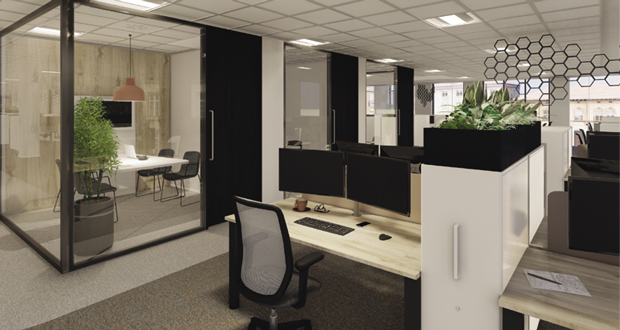 While FMs grapple with the realities of dealing with COVID and how to help their workplaces evolve as lockdown eases, the importance of organisational agility has been thrust firmly into the spotlight. Jon Wilson, Senior Workplace Consultant at office and interior design business, Claremont, explains more
While FMs grapple with the realities of dealing with COVID and how to help their workplaces evolve as lockdown eases, the importance of organisational agility has been thrust firmly into the spotlight. Jon Wilson, Senior Workplace Consultant at office and interior design business, Claremont, explains more
The last few months have been a master class in agility. It has been enforced on businesses of all shapes and sizes as offices closed and employees adapted to working from home. Now, FMs are playing an integral role in helping organisations reinvent themselves for this new agile era – not just with short-term workplace fixes, but long-term solutions that act on our agile experiences and re-examine our relationship with space.
The nature of how organisations use space has been changing for some time. We’ve already had the large scale move away from cellular working in favour of open plan offices. We’ve also had the introduction of activity-based working and the use of different zones to support mobility in the workplace. Now, COVID-19 is pushing this evolution further and even the least agile-ready organisations have started to make changes.
So, what changes can we expect to see in the wake of COVID-19?
One of the biggest changes we’ll see in the short to medium term is that of more space. Right now, social distancing has had a big impact on our psyche. We’re not going to feel comfortable in a crowded lift or train for some time.
At work, circulation spaces will become wider, lift capacity will be restricted, some areas may be decommissioned altogether, floor plates will be reconfigured, furniture will be moved and spacing between desks widened. New protocols will also be needed to help people enter, exit and circulate around spaces safely.
As space plans are revisited to take into account these new challenges – it’s likely to stimulate much wider discussion about spatial needs and priorities. If the majority of a 300 strong workforce can work from home, could a smaller office geared towards collaboration and client visits save money and present an agile alternative? In a post- COVID era, would offices better serve as brand hubs and places of significant shared experiences – rather than just a building to provide shelter from the elements? We fully expect to see more businesses asking these commercial, behavioural and aspirational questions and re-evaluating their needs with space utilisation studies, cost comparisons, behavioural analysis, staff surveys and new working models.
 SPATIAL CHANGES
SPATIAL CHANGES
At the point of our collective return to the office, personal space and control of that space will be important to many and this will require new things of facilities professionals. It will be a difficult balancing act as organisations seek to ride a possible bumpy recession by looking to optimise their people and property outlays. Space and the perception of space will be a priority.
Cleanliness is closely aligned with the need for space too. Not only will the workplace need to be seen to be cleaner, with regular sanitisation throughout the day, but employee etiquettes around respecting and maintaining cleanliness will have to be revisited and enforced. For some this will bring an abrupt end to the idea of shared spaces, which is particularly challenging to the ‘ours to share’ mantra of the agile office environment.
IMPROVING THE HOME OFFICE
Although the novelty of home working may be wearing off for many, our enforced agile pilot has sped up the acceptance and necessity of remote working for the masses. Employees with the right kit, support and training have enabled ‘business as usual’ scenarios for their organisations and FMs must now look to turn what started as short term fixes into longer term, workable agile strategies. This will raise other challenges in relation to formalised working from home protocols, how home-working set-ups are monitored, how duty of care for employees is maintained and how IT equipment, desks and chairs are paid for and maintained.





